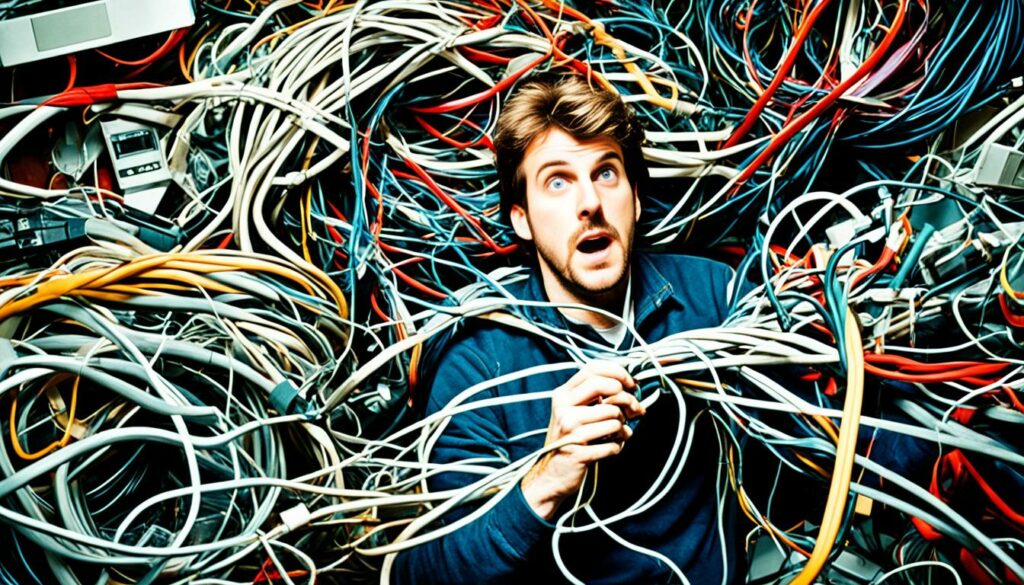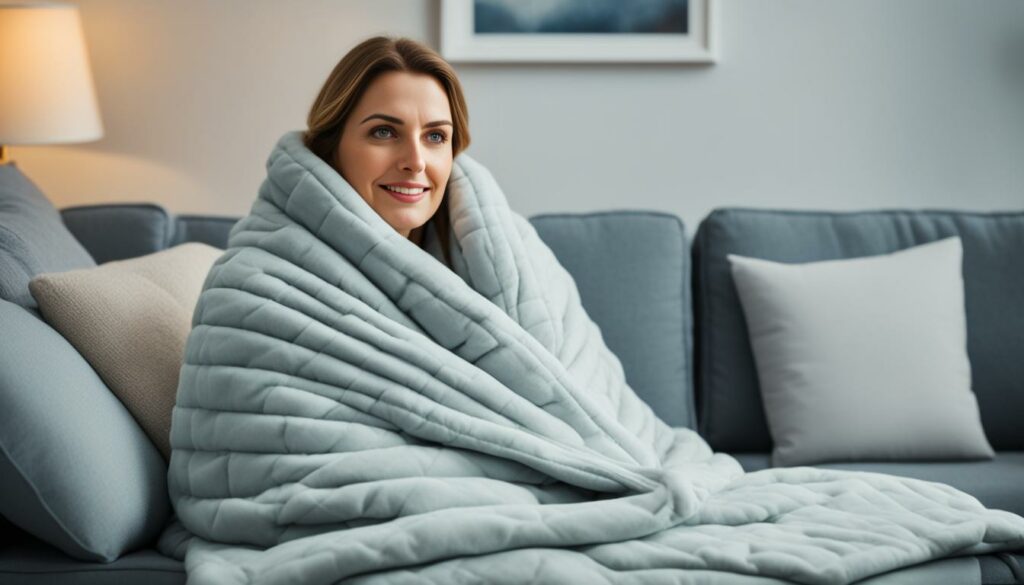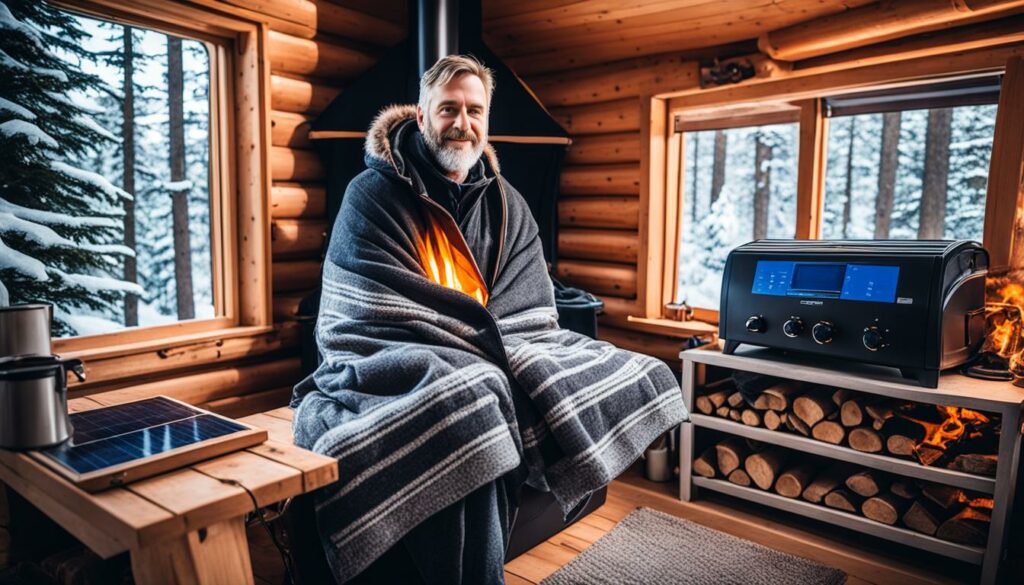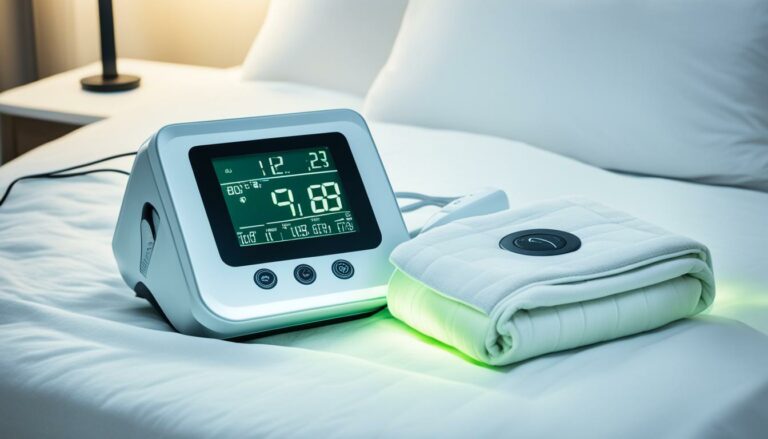Heated Blanket Watts: Efficient Warmth Guide
Eric Christie stands as a luminary in the bedding industry, with a career spanning nearly four decades since the early 1980s. His journey through the world of bedding has seen him wear many hats – a manufacturer, designer, and retailer, showcasing his versatility and expertise in Read more...
pillowsandbedsheets.com and its partners may earn a commission if you purchase a product through one of our links
When it comes to staying warm during chilly nights, electric blankets are a popular choice. But did you know that understanding the wattage of your heated blanket can help you maximize efficiency and save on energy costs? In this guide, we’ll explore the importance of heated blanket watts and how they affect energy consumption.
Electric blankets work by converting electrical energy into heat energy, providing you with cozy warmth as you sleep. The wattage rating of a heated blanket determines the power it consumes. Different blankets have varying wattage, typically ranging from 40 to 200+ watts depending on their size and settings.
It’s essential to consider the wattage of your heated blanket as higher heat settings and larger blankets tend to use more power. By calculating the energy consumption based on the wattage, hours used, and electricity rates, you can estimate the cost of running your electric blanket and make informed decisions about energy usage.
Key Takeaways:
- Understanding the wattage of your heated blanket can help you maximize efficiency and reduce energy costs.
- Electric blankets convert electrical energy into heat energy, providing warmth as you sleep.
- Wattage ratings of heated blankets range from 40 to 200+ watts, depending on their size and settings.
- Higher heat settings and larger blankets tend to consume more power.
- By calculating energy consumption, you can estimate the cost of running your electric blanket and make informed decisions about energy usage.
How Wattage Affects Energy Consumption
When it comes to using an electric blanket, understanding the wattage can have a significant impact on energy consumption. The wattage of a heated blanket directly determines how much power it utilizes. In simple terms, the higher the wattage, the more energy the blanket consumes.
Various factors contribute to the wattage rating of an electric blanket. These factors include the size of the blanket, the wiring gauge, and whether it has a single or dual zone controller. Each of these elements influences the specific wattage of the blanket.
By familiarizing yourself with the wattage of your electric blanket, you can estimate the amount of energy it consumes. This knowledge allows you to calculate the cost of running the blanket based on your electricity rates. Understanding the wattage is particularly helpful when managing energy consumption and optimizing usage.
To give you a practical example, let’s say you have an electric blanket with a wattage rating of 100W. If you use the blanket for eight hours, it would consume a total of 800 watt-hours (Wh), equivalent to 0.8 kilowatt-hours (kWh). Multiplying this value by your electricity rate, let’s say $0.12/kWh, would give you an estimated cost of $0.10 for running the blanket for eight hours.
Benefits of Knowing the Wattage
Understanding the wattage of your heated blanket offers several advantages. Firstly, it allows you to make informed decisions regarding energy consumption, enabling you to control and reduce your electricity usage.
Secondly, knowing the wattage helps estimate the overall cost of operating the electric blanket. This information is valuable for budgeting purposes and allows you to manage your expenses effectively.
By considering the wattage, you can also compare the energy consumption of different blankets to choose the one that aligns with your energy-saving goals.
Expert Tip:
When shopping for a new electric blanket, pay attention to the wattage rating. Opt for a blanket with lower wattage, as it will consume less power and save you money in the long run.
To visualize how the wattage affects energy consumption, take a look at the table below:
| Blanket Wattage | Energy Consumption (8 hours) | Estimated Cost (at $0.12/kWh) |
|---|---|---|
| 50W | 400 Wh (0.4 kWh) | $0.05 |
| 100W | 800 Wh (0.8 kWh) | $0.10 |
| 150W | 1,200 Wh (1.2 kWh) | $0.14 |
As you can see, higher wattage ratings result in increased energy consumption and higher costs. Opting for a blanket with a lower wattage can help minimize both your energy usage and expenses.
Now that you understand how wattage affects energy consumption, it’s time to explore strategies for estimating energy use and costs. Stay tuned for the next section!
Estimating Energy Use and Costs
Estimating the energy use and costs of running an electric blanket is an essential aspect of maximizing efficiency and effectively managing your budget. By understanding the wattage of the blanket and calculating the energy consumed, you can estimate the cost of running the blanket and make informed decisions.
To estimate the energy use, multiply the wattage of the blanket by the number of hours you plan to use it. This calculation gives you the energy consumed in watt-hours (Wh). For example, a 100W blanket used for 8 hours would consume 800 Wh.
To determine the cost of running the electric blanket, you need to convert the energy consumed from watt-hours to kilowatt-hours (kWh) and multiply it by your electricity rate. For instance, at an electricity rate of $0.12/kWh, using the previous example, the cost of running the electric blanket for 8 hours would be approximately $0.10 (800 Wh = 0.8 kWh).
By performing these energy consumption and cost calculations, you can gain insights into the impact of using your electric blanket and adjust your usage accordingly. It can help you make conscious decisions about when to use the blanket and for how long, enabling you to manage your energy costs effectively.
| Blanket Wattage | Hours of Use | Energy Consumed (kWh) | Cost (at $0.12/kWh) |
|---|---|---|---|
| 100W | 8 | 0.8 kWh | $0.10 |
| 150W | 6 | 0.9 kWh | $0.11 |
| 200W | 10 | 2.0 kWh | $0.24 |
Table: Sample Estimation of Energy Consumption and Costs for Electric Blankets
Myths and Misconceptions
When it comes to electric blankets, there are several myths and misconceptions that can lead to inefficient use. By debunking these myths, you can optimize the efficiency and effectiveness of your electric blanket.
One common myth is that newer electric blankets use less power. In reality, the wattage of the blanket is the primary factor that determines its energy consumption, regardless of its age. So, it’s important to pay attention to the wattage rating when selecting an electric blanket.
Another misconception is that thicker blankets equal better insulation. While thicker blankets may provide a feeling of coziness, the fabric thickness itself has minimal impact on the heat efficiency. It’s the wattage and settings of the blanket that determine how well it keeps you warm.
“Age matters less than wattage and settings, fabric thickness has minimal impact on heat efficiency.”
Some people also believe that only heating the bed saves energy. However, it’s important to remember that the human body itself generates substantial electricity, even while at rest. Heating only the bed may not be sufficient to provide the comfort and warmth you desire, especially during colder nights.
By understanding and correcting these myths and misconceptions, you can make informed decisions about your electric blanket usage and optimize its efficiency.

Debunking Electric Blanket Myths
| Myth | Reality |
|---|---|
| Newer electric blankets use less power. | Age matters less than wattage and settings. |
| Thicker blankets equal better insulation. | Fabric thickness has minimal impact on heat efficiency. |
| Only heating the bed saves energy. | The body itself uses substantial electricity. |
Tips for Optimal Usage
To maximize the efficiency and performance of your electric blanket, there are several tips you should keep in mind. By following these recommendations, you can ensure that you are making the most of your electric blanket while maximizing its efficiency and reducing energy consumption.
1. Establish a regular sleep schedule
Having a consistent sleep schedule helps you optimize the usage of your electric blanket. By setting a specific time to go to bed and wake up, you can program your blanket accordingly and avoid unnecessary energy consumption during idle hours.
2. Pre-heat your blanket
To achieve optimal warmth and coziness, pre-heat your electric blanket for 20-30 minutes before getting into bed. This ensures that the blanket is warm and ready to provide you with immediate comfort as soon as you crawl under the covers.
3. Use timers or auto-shut-off features
Take advantage of timers or auto-shut-off features on your electric blanket to avoid unnecessary power draw all night long. By setting the timer to turn off after a specific duration or utilizing the auto-shut-off feature, you can conserve energy and prevent excessive heating throughout the night.
4. Adjust to the lowest temperature setting
Start with the lowest temperature setting on your electric blanket and gradually increase it until you reach your desired level of warmth and comfort. Remember that even a slight adjustment can make a significant difference, allowing you to optimize efficiency and reduce power consumption.
5. Only heat the occupied side for dual-zone controllers
If you have a dual-zone electric blanket, only heat the side of the bed that is occupied. This targeted heating strategy helps minimize energy usage while still providing personalized warmth and comfort.
6. Follow manufacturer-provided cleaning instructions
To maintain the performance and longevity of your electric blanket, it is essential to follow the manufacturer’s cleaning instructions. Regularly clean your blanket as recommended to remove any dirt or debris that may affect its efficiency.
7. Inspect your blanket for damage
Frequently check your electric blanket for any signs of damage, such as frayed wires or worn-out fabric. Damaged blankets may not operate efficiently, and in some cases, can be hazardous. If you notice any issues, discontinue use and consult the manufacturer for repair or replacement.
8. Use other heating methods strategically during the day
During the day, consider using other heating methods strategically to reduce your reliance on the electric blanket. Utilize natural sunlight, open curtains to let in warmth, or use space heaters in specific areas instead of heating the entire house. This allows you to conserve energy and further maximize the efficiency of your electric blanket.
By following these tips for optimal usage, you can enjoy the maximum benefits of your electric blanket while minimizing the impact on your energy consumption and costs.

| Tips | Description |
|---|---|
| Establish a regular sleep schedule | Setting a consistent sleep schedule helps optimize your electric blanket’s usage. |
| Pre-heat your blanket | Pre-heating your electric blanket ensures immediate warmth and comfort when you get into bed. |
| Use timers or auto-shut-off features | Utilizing timers or auto-shut-off features prevents unnecessary power consumption during idle hours. |
| Adjust to the lowest temperature setting | Starting at the lowest temperature and gradually adjusting helps optimize efficiency and minimize energy consumption. |
| Only heat the occupied side for dual-zone controllers | For dual-zone electric blankets, only heat the side of the bed that is occupied to conserve energy. |
| Follow manufacturer-provided cleaning instructions | Regularly clean your electric blanket as per the manufacturer’s instructions to maintain its performance. |
| Inspect your blanket for damage | Regularly check your electric blanket for any signs of damage that may affect its efficiency or safety. |
| Use other heating methods strategically during the day | Opt for alternative heating methods during the day to reduce reliance on the electric blanket. |
Energy-Efficient Alternatives
Are you searching for energy-efficient alternatives to traditional electric blankets? Look no further! We have some options that are designed to provide cozy warmth while consuming less power. One such alternative is the low wattage heated blanket.
Low wattage heated blankets are specifically designed to be energy-efficient, with wattages below 100W. These blankets offer the perfect combination of warmth and conservation, allowing you to stay cozy while reducing energy consumption.
But that’s not all! If you’re looking to further reduce reliance on electric blankets, there are additional heating methods to consider. Heated furniture is a great option to explore. Imagine curling up in a chair or lounging on a warm couch, getting that extra bit of warmth without relying solely on electric blankets.
Another tip to reduce dependency on electric blankets is to strategically use central heating or space heaters. By using these heating methods in conjunction with your low wattage heated blanket, you can create a comfortable and energy-efficient environment.

As you can see, there are plenty of alternatives to traditional electric blankets that can help you optimize energy usage without compromising on warmth and comfort.
Off-Grid Heating Solutions
In situations where there is no access to traditional power sources, portable power stations can provide off-grid heating solutions for electric blankets. These power stations, such as the EcoFlow DELTA Pro and EcoFlow 400Wh Portable Power Station, have the capacity to power electric blankets for hours or days between charges.
By utilizing renewable energy sources like solar panels or traditional charging methods, these portable power stations can keep electric blankets running off-grid. This provides a reliable and eco-friendly option for heating when traditional electricity is not available.
Whether you’re camping in the wilderness, living in a remote area, or experiencing a power outage, portable power stations offer a convenient solution to stay warm with your electric blanket.

With their compact size and portable design, these power stations are easy to carry and can be recharged using various methods. Some models even come with built-in solar panels for sustainable charging on the go.
Having an off-grid heating solution ensures that you can still enjoy the cozy warmth of your electric blanket, even when you’re far away from conventional power sources. It not only provides peace of mind but also reduces reliance on fossil fuels and minimizes your environmental footprint.
Investing in a portable power station for your electric blanket is a wise choice for those who value comfort, convenience, and sustainability. With the ability to power your blanket for extended periods, you can stay warm and cozy wherever your adventures take you.
Conclusion
By understanding the wattage of a heated blanket and following energy-efficient practices, you can enjoy the warmth and comfort of electric blankets without significantly impacting your energy bills. It is important to optimize usage by adjusting settings, following manufacturer guidelines, and considering alternative heating methods to increase efficiency and reduce energy consumption.
With proper knowledge and usage habits, electric blankets can provide cozy warmth during colder nights while minimizing the cost of energy consumption. By paying attention to the wattage rating and calculating energy usage and costs, you can make informed decisions about how to use your electric blanket effectively.
Remember to establish a regular sleep schedule, pre-heat the blanket before getting into bed, and utilize features like timers or auto-shut-off to avoid unnecessary power draw. Additionally, inspect and clean your blanket regularly, and consider low-wattage alternatives or off-grid heating solutions if you are looking for more energy-efficient options.
FAQ
How does the wattage of a heated blanket affect its energy consumption?
The wattage of a heated blanket directly affects its energy consumption. The higher the wattage, the more power the blanket uses. Different factors such as the blanket size, wiring gauge, and single or dual zone controllers can influence the specific wattage rating.
How can I estimate the energy use and costs of running an electric blanket?
To estimate the energy use and costs of running an electric blanket, multiply the wattage of the blanket by the hours used to calculate the energy consumed in watt-hours. Convert this to kilowatt-hours (kWh) and multiply it by your electricity rate to estimate the cost.
What are some common myths and misconceptions about electric blankets?
Some common myths include believing that newer blankets use less power, that thicker blankets equal better insulation, and that only heating the bed saves energy. In reality, age matters less than wattage and settings, fabric thickness has minimal impact on heat efficiency, and the body itself uses substantial electricity.
What tips can help me maximize the efficiency of my electric blanket?
To maximize efficiency, establish a regular sleep schedule, pre-heat the blanket for 20-30 minutes before getting into bed, use timers or auto-shut-off features, adjust to the lowest temperature setting, and only heat the occupied side for dual zone controllers. Follow manufacturer instructions for cleaning and inspect the blanket for damage.
Are there energy-efficient alternatives to traditional electric blankets?
Yes, low wattage heated blankets are designed to consume less power while still providing warmth. These blankets typically have wattages below 100W, making them more energy-efficient. Additionally, considering alternative heating methods such as heated furniture or strategically using central heating or space heaters can help reduce reliance on electric blankets.
What are some off-grid heating solutions for electric blankets?
Portable power stations, such as the EcoFlow DELTA Pro and EcoFlow 400Wh Portable Power Station, can provide off-grid heating solutions for electric blankets. These power stations have the capacity to power electric blankets for hours or days between charges. Utilizing renewable energy sources or traditional charging methods, these portable power stations can keep electric blankets running off-grid.
What can I do to reduce the cost of running my electric blanket?
By understanding the wattage of a heated blanket, adjusting settings, following energy-efficient practices, and considering alternative heating methods, you can reduce the cost of running your electric blanket. This includes using a low wattage heated blanket, optimizing usage, and exploring off-grid heating solutions.
Eric Christie stands as a luminary in the bedding industry, with a career spanning nearly four decades since the early 1980s. His journey through the world of bedding has seen him wear many hats – a manufacturer, designer, and retailer, showcasing his versatility and expertise in Read more...







